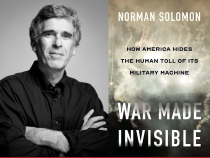How the United States Covers Up the Real Costs of War
By:
emilyFriday, August 25, 2023

By Dora Usdan, Summer 2023 intern
Norman Solomon’s new book War Made Invisible: How America Hides the Human Toll of Its Military Machine examines the tactics used by the United States and the media to conceal the human costs of war, such as stifling antiwar dialogue, using technology to distance enemy victims of military action from the public eye, and controlling media intervention into the subject. We’ve put together a list of nine eye-opening points Solomon makes to illuminate what principled citizens should look for behind the mainstream justifications for future conflicts.
America’s post 9/11 “forever war” encouraged continual systemic racism.
“The rhetoric of the ‘war on terror’ supplied a smokescreen that made it harder to see how militarism and racism were fondling each other in a death grip.” (p. 143) Media tropes are carefully crafted to create a “clean” narrative to absolve Americans of any guilt pertaining to the relationship between race and war. The connections between race and war are reflected in the racist, violent institutions of policing and incarceration.
War critics are actively silenced.
When former MSNBC newswoman Ashleigh Banfield spoke out about the human costs of war in Iraq, it halted and reversed her career advancement. Banfield later described the “cruelty and the manner in which [Neal Shapiro, president of NBC] decided to dispose of [her].” (p. 74) For Banfield, speaking about the war’s victims cost her her career, an example of the fragility of freedom of speech in corporate media.
Democracy only functions well when opposing voices are given significant space in public discourse.
Only one of 878 sources who appeared on TV news of major networks during the 1991 Gulf War represented antiwar sentiment from a national peace organization. For the “War on Terror,” the government solicited national support while opponents were largely silenced. “Erasure – journalistic, psychological, political – has always been a ‘war on terror’ subtext.” (p. 136)
Avoiding civilian deaths is not an explicit goal for the U.S. government.
Foreign civilians and enemy forces killed or injured in the post 9/11 wars are unseen and unheard in American dialogue. “Unmentioned are estimates like the one from Brown University’s meticulous Costs of War program that conservatively put the number of civilians killed ‘directly in the violence of the U.S. post-9/11 wars’ at upwards of 364,000 during the first two decades.” (p. 54) Calculated erasure helps foster an “us and them” mentality among Americans. Without empathy for victims of U.S. wars, American citizens become a part of the mechanisms of war.
America’s wars rely on the strong roots of militarism in the United States.
“The war machinery depends on a steady supply of humans. For warfare, young males are the essential product.” (p. 121). The sensationalism of heroism from war appeals to younger generations. There are often huge incentives for young adults to enlist, like free college tuition. Members of the military are desensitized to violence and warfare, cementing violence into the culture of growing up in America, specifically the fixation on and idealization of guns.
Technology enables war to slip from the forefront of American minds into invisibility.
“The fewer the American soldiers in harm’s way, the more abstract the warfare [becomes] for the U.S. mass media and its customers – while the appropriators kept voting to fund the wars that fewer and fewer constituents seemed to know about or care much about.” (p. 13) In reality, technology like drones has made loss of American soldiers less frequent but has done little to limit civilian deaths.
The U.S. government and media categorizes countries as "friend" or "foe".
“Nationalism masquerading as journalism covers war in darkness and light, telling us for whom the bell tolls.” (p. 35) Bias dramatically shifts the United States’ political stance. Russia’s atrocities against Ukraine were on the front page of every major newspaper. When the U.S. commits atrocities, there is little reporting, even in more liberal news outlets.
Many of America’s large corporations depend on ongoing war to maximize profits.
There are real economic benefits to war that incentivize corporations to support military spending. Corporations like Boeing, Lockheed Martin, and General Dynamics profit from militarization as they provide weapons and gear for the government. “It’s difficult, maybe impossible to imagine the U.S. economy without massive military spending, or the country without warfare abroad or the (rarely noted) ongoing operations of some 750 U.S. military bases abroad.” (p. 158) Money dominates politics, and those at the top of the financial pyramid continue to benefit and prosper from war as others lose their lives.
The violence of wars abroad returns to haunt us in the U.S.
Veterans exposed to high levels of violence in warfare are more likely to be violent after their return to the United States due to normalization of violence and psychological trauma. “About 33 percent of combat veterans with PTSD report having been aggressive with their intimate partner… [and] about 91 percent of combat veterans with PTSD reported being psychologically aggressive with their intimate partner in the previous year.” (p. 169-170)
